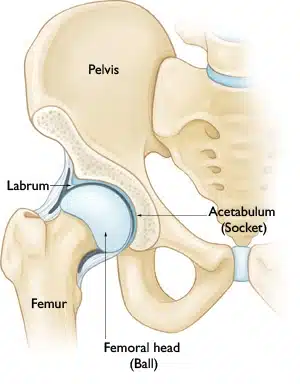
Shoulders and hips are often described using the “ball and socket” comparison. Over the past few weeks, I have seen an increase in shoulder conditions in the office, even more frequently than hip complaints. When discussing the anatomy with the patient, I always mention the term “ball and socket,” but I like to take it a step further and explain how the shoulder is different from the hip.
If you try moving your shoulder, you notice that it can go 360 degrees around in rotation, whereas the hip hits some hard end ranges. This is due to the nature of the ball and socket joint. A good way to note difference is by thinking of the shoulder as more of a golf ball sitting on a golf tee and the hip as a true ball in socket.

After looking at the anatomy above, you can see the shoulder joint is made up of the head of the humerus, which rests on the glenoid fossa of the scapula (or shoulder blade). Where as the hip joint is the head of the femur that fits into the acetabulum of the ilium (pelvic bones). So, as one of my college professors always said, this makes the shoulder like one of your family members, a little unstable (he had some jokes!).
This means that shoulder injuries are normally more soft tissue in nature. The shoulder blade itself is a floating bone, adhered to the back of the ribs by muscles. The humerus is held to the shoulder blade by the 4 muscles that make up the rotator cuff. The only joint holding your shoulder girdle to the rest of your body is the sternoclavicular joint – the area where your collarbone meets your chest bone.
The hip joint is a little tricky because of the way our bodies develop, and it is a tough area to work on. It is more weight bearing so, yes, we do have a lot of muscles around it. However, the joint itself can suffer from degeneration and things like femoral acetabular impingement (where the head of the femur does not fit like Cinderella’s slipper in the acetabulum). We’ll discuss this more next time!
But back to the shoulder. If you do suffer from shoulder pain, think more about muscle involvement before anything else. Some self-tests you can do are looking at rotation: Can you make an entire circle with your arm without pain? Does your arm get stuck in certain places if you rotate it up? How about rotating it down? Is there numbness, tingling, or loss of strength? If most of your tests only produce pain with movement and not loss of strength or change in sensation, you may benefit from soft tissue manipulation and other chiropractic modalities rather than needing more invasive procedures right away!
As always, consult with a healthcare provider regarding your shoulder pain. Conservative treatment such as graston, myofascial release and therapies may be beneficial to get you back to your active life style. If you have any questions feel free to call Stumpff Chiropractic at 954-368-4054 or visit us for more information.
